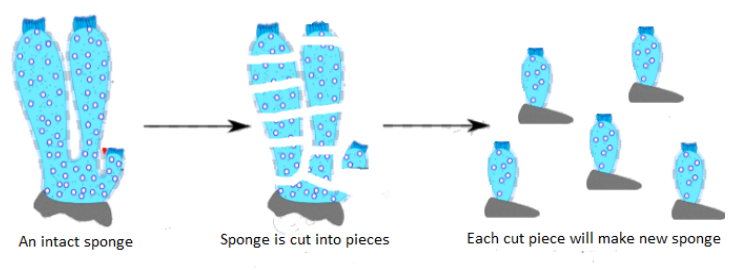
What will happen if a sponge is cut into maximum possible pieces?
A. These will die
B. These will differentiate
C. Every piece will form a sponge
D. Some pieces will develop into organs
Answer
468.9k+ views
Hint: The sponges belong to the phylum Porifera. The sponges exhibit the power of regeneration that is to grow from cut parts. They reproduce asexually by fragmentation. so, if a sponge is cut into several pieces it will show the power of regeneration.
Complete step by step answer: Sponges are multicellular sessile (immobile) organisms that come under primitive animals. It belongs to the phylum Porifera. The amoebocyte cells in sponges help them to regenerate. Regeneration is the process of developing self. This means that each part or tissue of the sponge can regenerate to form another sponge. Moreover, they reproduce asexually by fragmentation. This means that each fragment develops into an individual sponge.

Option A says that each piece of sponge will die. This cannot happen as individual cut pieces of sponges will have the potential to reproduce asexually into an individual sponge.
Option B says that each cut piece will differentiate. Differentiation is a process of specialization. It means that one cell type will form another specialized cell type with a different function. But differentiation in the sponge will occur when each piece will develop into an individual sponge.
Option C says that each cut piece will form a sponge. This is true as each piece will retain the power of regeneration and will reproduce asexually forming a whole sponge.
Option D is invalid as a sponge does not consist of any specialized organ. It is hollow from the inside and only has three body layers with pores on the outer layer. They lack true tissues and organs. Thus, no organ will be formed from any piece rather these will develop into the whole sponge body.
Thus, the right answer is option C.
Note: Sponges live in marine habitats. They are sessile animals meaning that they stay attached to some hard surface for support. They are considered the first to branch off the evolutionary tree from the common ancestor of all the animals. Thus they are very simple in their structure and cannot reproduce by complex means. This gives the ability to reproduce by fragmentation and exhibit regeneration.
Complete step by step answer: Sponges are multicellular sessile (immobile) organisms that come under primitive animals. It belongs to the phylum Porifera. The amoebocyte cells in sponges help them to regenerate. Regeneration is the process of developing self. This means that each part or tissue of the sponge can regenerate to form another sponge. Moreover, they reproduce asexually by fragmentation. This means that each fragment develops into an individual sponge.

Option A says that each piece of sponge will die. This cannot happen as individual cut pieces of sponges will have the potential to reproduce asexually into an individual sponge.
Option B says that each cut piece will differentiate. Differentiation is a process of specialization. It means that one cell type will form another specialized cell type with a different function. But differentiation in the sponge will occur when each piece will develop into an individual sponge.
Option C says that each cut piece will form a sponge. This is true as each piece will retain the power of regeneration and will reproduce asexually forming a whole sponge.
Option D is invalid as a sponge does not consist of any specialized organ. It is hollow from the inside and only has three body layers with pores on the outer layer. They lack true tissues and organs. Thus, no organ will be formed from any piece rather these will develop into the whole sponge body.
Thus, the right answer is option C.
Note: Sponges live in marine habitats. They are sessile animals meaning that they stay attached to some hard surface for support. They are considered the first to branch off the evolutionary tree from the common ancestor of all the animals. Thus they are very simple in their structure and cannot reproduce by complex means. This gives the ability to reproduce by fragmentation and exhibit regeneration.
Recently Updated Pages
Master Class 11 Accountancy: Engaging Questions & Answers for Success

Express the following as a fraction and simplify a class 7 maths CBSE

The length and width of a rectangle are in ratio of class 7 maths CBSE

The ratio of the income to the expenditure of a family class 7 maths CBSE

How do you write 025 million in scientific notatio class 7 maths CBSE

How do you convert 295 meters per second to kilometers class 7 maths CBSE

Trending doubts
10 examples of friction in our daily life

One Metric ton is equal to kg A 10000 B 1000 C 100 class 11 physics CBSE

Difference Between Prokaryotic Cells and Eukaryotic Cells

State and prove Bernoullis theorem class 11 physics CBSE

What organs are located on the left side of your body class 11 biology CBSE

Write down 5 differences between Ntype and Ptype s class 11 physics CBSE




